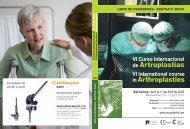cadera / hip - Active Congress.......
cadera / hip - Active Congress.......
cadera / hip - Active Congress.......
Create successful ePaper yourself
Turn your PDF publications into a flip-book with our unique Google optimized e-Paper software.
JUEVES / THURSDAY<br />
236<br />
consequently accentuated wear 5 . Overrelease<br />
of the collateral structures may result in symptomatic<br />
instability 6 . Mild to moderate increased<br />
varus-valgus laxity in extension has been reported<br />
to be of no clinical importance 7 . However,<br />
major instability may be an important cause for<br />
total knee arthroplasty failure 8 and accounted<br />
for 21% of 212 revision total knee arthroplasties<br />
in the series by Sharkey et al .9 . Fehring et al. 10<br />
reported on 27% instability cases in their total<br />
knee revision population of 440 patients who<br />
had to be revised after a follow-up of less than<br />
5 years after primary TKA.<br />
Increased varus or valgus laxity in fl exion<br />
due to femoral component malrotation has<br />
extensively been examined in cadaveric studies<br />
under loaded 11 and unloaded conditions 12 .<br />
Although femoral component malrotation is<br />
considered the major cause for fl exion gap<br />
imbalance 12,13 little is known on the clinical<br />
consequences. Laskin 14 reported on patients<br />
with medial tibial pain if the femoral<br />
component was not externally rotated to<br />
allow rectangularization of the fl exion gap.<br />
Varus and valgus laxity in fl exion might be<br />
diffi cult to quantify by clinical examination.<br />
In a cadaver study, Grood et al. 15 compared<br />
manually assessed medial and lateral<br />
joint opening with varus and valgus laxity<br />
determined by means of an Instron testing<br />
system. They proved that erroneous laxity<br />
assessment in fl exion is likely to occur by<br />
clinical examination even when the primary<br />
restraint is missing and the testing system<br />
demonstrates a large joint opening. The application<br />
of fl uoroscopic stress radiography on<br />
a patient lying relaxed on a designated radiolucent<br />
bench is a feasible, inexpensive, fast,<br />
safe, and reproducible method for detecting<br />
increased varus-valgus laxity of the knee in<br />
fl exion on a routine base 16 . The moment applied<br />
to the tibia has to be pain free avoiding<br />
quadriceps and hamstrings cocontraction,<br />
which increases tibiofemoral joint reaction<br />
force and decreases joint opening 17 .<br />
A recent study using a three-dimensional<br />
interactive model-fi tting technique for twodimensional<br />
fluoroscopic dynamic images<br />
confi rms that increased femorotibial separation<br />
(“condylar lift-off”) under weight-bearing<br />
conditions in fl exion was more pronounced<br />
on the lateral side, and was associated with<br />
femoral component malrotation 18 . A study<br />
by Stiehl et al. confi rms that condylar lift-off<br />
occurs in clinically successful total knee<br />
replacements 19 , but it is not known to what<br />
extend this condition may be clinically tolerated.<br />
An exaggerated condylar-lift off due to<br />
increased lateral fl exion laxity because of a<br />
malrotated femoral component may disturb<br />
knee kinematics and ultimately accentuate<br />
edge loading, which has been implicated as<br />
a cause of premature polyethylene failure 20 .<br />
A study using the WOMAC score as clinical<br />
outcome measurement revealed that there are<br />
specifi c symptoms associated with increased<br />
fl exion gap imbalance due to internal femoral<br />
component malrotation 21 . The predominant<br />
patient complaints were pain on stair climbing,<br />
reduced function on descending stairs and<br />
raising from a chair, and diffi culties getting in<br />
and out of a car or getting in and out of bath.<br />
Attfi eld et al. 22 reported also on knees which<br />
were not balanced in fl exion but fully balanced<br />
in extension. Proprioception was reduced in<br />
such knees compared to knees which were<br />
properly balanced in fl exion and extension.<br />
An important goal during surgey must be a<br />
well balanced knee not only in extension but<br />
also in fl exion. Proper femoral component<br />
rotation reduces fl exion gap imbalance.<br />
Bibliography<br />
1. Freeman MAR: Anonymous Arthritis of the knee:<br />
Clinical features and surgical management.<br />
Springer-Verlag, New York, 1980<br />
2. Insall JN: Choices and compromises in total knee<br />
arthroplasty. Clin Orthop 226:43, 1988<br />
3. Insall JN: Surgical techniques and instrumentation<br />
in total knee arthroplasty. In Insall JN, Windsor<br />
RE, Kelly MA, Scott WN, Aglietti P (eds): Surgery<br />
of the knee. Churchill Livingstone, New York,<br />
Edinburgh, London, Madrid, Melbourne, Tokyo,





